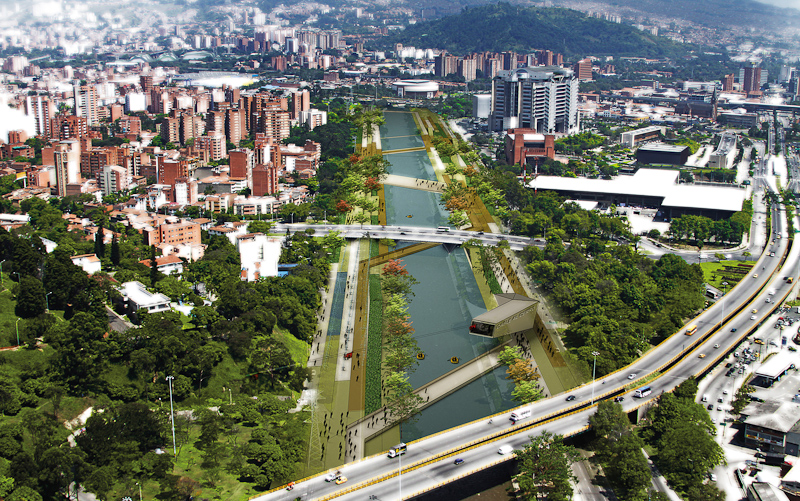Reshaping A City By Building Equity

Mention “Colombia” and most people would think of drugs, violence and poverty.
While the country’s struggle against drug trafficking and poverty persists, it has certainly made impressive headway in reducing violence while spurring urban renewal.
Take Medellin (“me-de-jin”), a city of 2.5 million people.
It was once dubbed the Murder Capital of the World with a peak of 380 murders per 100,000 people, or about 17 murders per day, in 1991. Living in Medellin was described as “hellish”, especially during the decades when drug lord Pablo Escobar held his reign of terror.
With Escobar’s death in 1993, the city began turning around. Observers credit a succession of leaders, starting with Mayor Luis Peres in 2001, who rejected the drug gangs’ propensity for violence for an agenda of peace and development.
By 2013, the homicide rate had plunged to 38 per 100,000 – still a high rate but one that continues to drop.
Last year, the city’s transformation was recognised by think tank Urban Land Institute, which named it the Most Innovative City over 200 contenders, including New York City.

Economic disparity
Today, Mayor Anibal Gaviria Correa, who took office in 2012, is continuing the work that his predecessors began.
He says “an obsession to build equity” is central to their efforts, owing to the glaring economic disparity in Medellin.
A local study on quality of life found a 20-point difference between the richest (in the south) and poorest (in the north) neighbourhoods, as if “you have many cities in the same city”, he remarked.
Medellin has therefore focused on investing resources in the poorest, most violent areas, such as the slums dotting the hills around the city.

Tools to boost equity
Equity, Mayor Gaviria says, can be built with many “tools”, but the most important one is education, as it “gives capacity to people to determine their own lives”.
Hence, the city started by improving the quality of teaching and building public libraries, museums and schools in the poorer areas.
Making public spaces and transportation available and accessible has been another priority.
The city now boasts a free public bicycle programme, a bus rapid transit, as well as a sleek and quiet Metro train system.
Of note are two innovative transport systems: electric cable cars and a massive sheltered escalator in Medellin’s poorest and most dangerous neighbourhoods. Together, they ferry tens of thousands of people down the hills each day. Going downtown now takes minutes, instead of hours.
“For us, it’s important that there’s no difference between a person who has the most wonderful car and the person who doesn’t; he can still go to work with quality of life,” said the mayor. “I can say [that] when you’re going in the Metro in Medellin, you’re faster and more comfortable than a person in his car, along the Metro.”
News reports cite residents who say these improvements have given them a sense of dignity and pride.

Bigger plans to come
The mayor’s plans to continue expanding public spaces include cleaning up the polluted Medellin River, and the creation of a 75-km Green Belt of parks, hiking trails, bikeways and monorails on the slopes of the valley encircling Medellin.
“This is my dream,” said the mayor, as he sketched his plans on a piece of paper. “A Green Belt, river parks, and in the future these creeks will have linear parks to connect the Green Belt and river parks.
“But this isn’t a matter of just being green… it is a matter of equity and development in the periphery. We want to make the periphery ‘centre’ because in many cities, you have development in the centre and none in the periphery.”

Everyone’s got to chip in
Still, Medellin’s leaders have recognised that sweeping infrastructural changes aren’t enough for sustainable long-term change. So they have actively involved the community in improving their city.
The mayor highlights the practice of “participatory budgeting”, a concept that originated in Brazil in 1989, as an example of how community engagement is done.
Medellin is one of the few cities in the world to set aside a part of the annual city budget (5%) for citizens to define priorities for their neighbourhoods. This has resulted in “small bridges, community halls, common areas … scholarships … loans to people”, the mayor elaborated.
Though the projects are small, the scheme has been lauded by residents.
“Participatory budgeting is a very valuable way for the youth to understand how, with a resource, I can try to solve the problems of my community,” resident Jhon Jaime Sanches told NPR News. Mr Sanches tapped the budget to build up his music band, which operates out of the hilly slums of Medellin, and gives free music classes to the children in the area.
More reasons to be happy
According to legislation, Colombian mayors can only run for office once, so Mayor Gaviria will have to end his term in 2015. But the Medellin native, who once roamed the streets on a bicycle with his seven siblings, is confident that his plans will materialise.
He pointed out that there has been a continuity of projects in the past 12 years “because community takes ownership”. A Master Plan drawn up by his office will also guide future mayors’ work.
A 2013 Gallup survey, which found Colombians to be the happiest people among 54 countries, ranked Medellin residents as the second happiest in the country, after the residents of coastal city Barranquilla.
If the mayor’s ambitious plans succeed, they will have even more reasons to be happy.
- POSTED ON
Nov 26, 2014
- TEXT BY
Bridgette See









